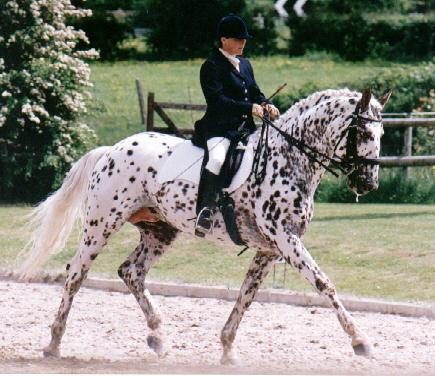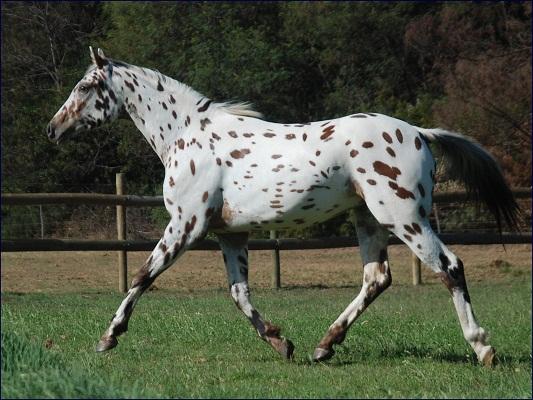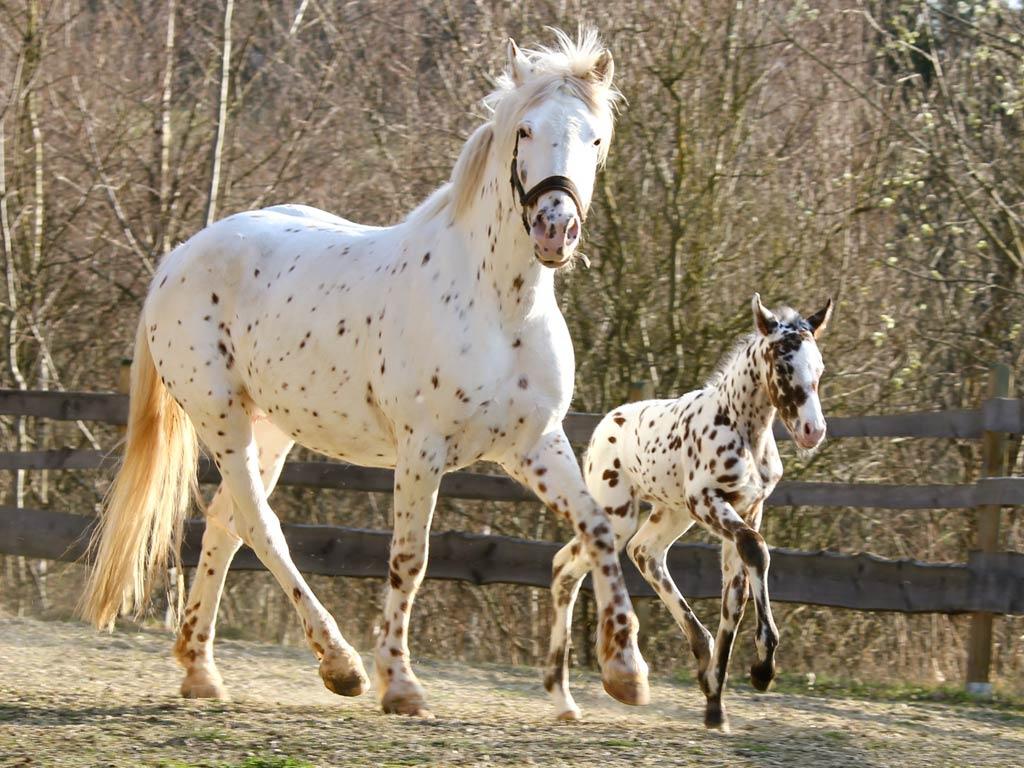
Continent: Europe
Country: Denmark
Weight: 450 – 550 kg
Height: 150 – 160 cm


The Knabstrupper is a breed that originated in Denmark, specifically on the Knabstrup estate near Holbæk, in the region of Sealand (Sjælland).
Its history dates back to the early 19th century, when a spotted mare, often referred to as Flæbehoppen, likely of Spanish or Neapolitan origin, was acquired by Major Villars Lunn, the owner of the Knabstrup estate.
This exceptional mare, with her distinctive "leopard" coat, was crossed with local stallions and produced offspring that were strong, versatile, and inherited the striking spotted pattern. These horses quickly gained fame for their endurance, strength, and eye-catching appearance, becoming popular for war and carriage use throughout the region.
With the advent of mechanization and the impact of wars, the Knabstrupper population came close to extinction. The breed was saved in the 20th century thanks to a few passionate breeders and was revived through carefully managed crossbreeding, notably with Appaloosas, to restore the spotted coat pattern.
The Knabstrup is historically native to Denmark, particularly the Sealand region where the original Knabstrup estate was located. Today, breeding is still active in Denmark under the supervision of the official Danish association.
Knabstrup breeding also exists in several European countries, including Germany, the Netherlands, and Sweden, where the breed is valued for its spectacular coat and versatile temperament.
Since the 2000s, the Knabstrup has also gained popularity in North America, thanks to a few specialized breeders in the United States and Canada, often focusing on leisure, performance, or western disciplines.
The Knabstrup has a unique genetic heritage, inherited from the founding stallion Flæbehingsten, which gives the breed its famous leopard-spotted coat.
This rare characteristic makes the Knabstrup a valuable breed in breeding programs aiming to preserve or introduce this coat pattern. Beyond appearance, the Knabstrup also stands out for its genetic diversity, which is especially important in the context of breeds with small populations.
It is sometimes used in controlled crossbreeding to pass on desirable traits such as a steady temperament, good endurance, and hardiness. These qualities make it a popular choice for breeding leisure or show horses and have led to experimental crossings with breeds such as the Lusitano or Appaloosa.
The Knabstrup originated in the early 19th century in Denmark, on the Knabstrupgård estate that gave the breed its name. The breed descends from a spotted Spanish mare called Flæbehoppen, captured during the Napoleonic Wars and purchased by Major Villars Lunn, owner of the estate.
Crossed with various stallions, this mare gave birth to a line of horses with spectacular coats and spirited temperaments. The Knabstrup quickly became popular in Denmark as a cavalry and light draft horse.
However, a fire in 1891 destroyed much of the original herd, resulting in a major loss of genetic material. The breed declined throughout the 20th century and nearly disappeared.
In the 1970s, a reconstruction program was launched, including controlled crossings with Appaloosas to reintroduce the spotted coat and revive the breed.
Since then, the Knabstrup has regained some vitality while remaining a rare and carefully monitored breed, seen as a symbol of Danish heritage and equine originality.
The Knabstrup is known for its even-tempered, calm, cooperative, and intelligent nature.
It is considered a quick learner, making it a valued partner in many disciplines, especially dressage, equestrian shows, and leisure riding. It generally shows a good willingness to work, being neither too hot nor too dull, which makes it suitable for riders of all experience levels.
Its curious and social nature makes it pleasant to handle, both in hand and under saddle. Some individuals, especially from sportier lines, may show a strong personality, requiring a trusting rider-horse relationship.
“With its leopard spots and curious gaze, the Knabstrup is a horse that never goes unnoticed—neither in the landscape… nor in the hearts of those who meet it.”
The Knabstrup is enjoying a renewed international interest, largely due to its unique coat pattern and versatile nature.
This growing popularity opens up promising prospects, both in artistic equestrian disciplines (such as shows, dressage, and leisure riding) and in controlled crossbreeding programs aimed at preserving or introducing specific traits especially the leopard coat.
However, the breed remains relatively rare and requires careful genetic management to avoid inbreeding and maintain diversity.
The efforts of Danish and international breeding associations should help strengthen the Knabstrup’s recognition while maintaining its morphological and behavioral standards.
In the long term, the breed could play a greater role in promoting unique and expressive horses, suited to modern, sensitive, and show-oriented riding.
The Knabstrup is generally considered a hardy and robust breed, well adapted to European climates. However, like many breeds that carry the leopard complex (LP) gene, responsible for the spotted coat, it may have a predisposition to congenital stationary night blindness (CSNB)—particularly when homozygous for the gene.
As a result, selective breeding is crucial to minimize this risk.
Apart from that, no major breed-specific health issues have been identified. The Knabstrup typically enjoys good longevity, a strong skeletal structure, and a balanced metabolism, provided it receives proper veterinary care like any other horse.
A natural four-beat gait, even and regular, where each foot lands one after the other. The Knabstrup's walk is typically wide, supple, and well-balanced, reflecting its calm and willing disposition.
A two-beat symmetrical gait with a moment of suspension between each diagonal pair. The Knabstrup shows good elevation and a fluid movement in trot, making it ideal for both dressage and carriage driving.
Born on 01/01/1818
Mikkel is the most famous horse of the Knabstrup breed. Son of the mare Flaebe, the breed's foundation mare, he became renowned for his remarkable speed on the racetrack, winning every race except one at the age of 16, in Copenhagen. He was also known for his extraordinary endurance, once pulling a carriage over 41 km just to reach the starting line. Mikkel played a major role in building the breed’s reputation as a strong and enduring working horse.